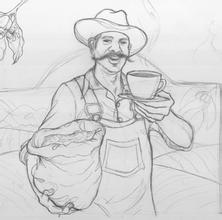Introduction of Arabica Coffee Flavor description method Grinding scale Taste production area
Arabica Coffee Flavor Description Processing Method Grind Scale Taste Introduction
"Arabica" coffee has a variety and a wide range of potential flavors. Arabica coffee produced in different regions, at different altitudes and in different climates usually has its own characteristics and can show very different personality flavors. "Arabica" coffee smells like grass when it is not roasted, and when properly roasted, it shows "fruity"(medium light roast) and "caramel sweet"(deep roast), generally with better aroma and flavor than Robusta beans.
Arabica coffee accounts for 75 percent of the world's coffee production, and quality varies widely, from good to bad. In recent years, a few countries (such as India) have made efforts to improve the quality of Robusta coffee. They grow Robusta coffee at high altitude, apply the most careful care and fine washing treatment, and the result is very excellent quality Robusta coffee beans! Top Robusta beans are not cheap either, get rid of the old impression that Robusta is all cheap beans! So the quality of coffee beans can no longer be judged by the crude and outdated old standard of "Arabica beans."
Robusta coffee generally has a bland, dull, pungent flavor, and because most of the world's Robusta coffee is grown at low altitudes (author's note: as of May 2008, only India has rare high-altitude, high-quality, washed Robusta coffee beans), the flavor differences between different regions and different climates are not too large, and there is a lack of personality. When unroasted, it smells like raw peanuts. Cheap Robusta coffee beans usually exhibit a taste between "wheat tea flavor"(medium light roast) and "rubber tire flavor"(deep roast) after roasting, and it is difficult to show detailed flavor.
Bourbon is almost entirely round beans, a little smaller than iron pickup, ripening later, but yielding 30% more than iron pickup. It is suitable for growing at altitudes above 1200 meters, and the flavor is obviously more prominent than that below 1000 meters. However, Bourbon has a disadvantage that it ends up resting for a year. Round bourbon is vigorous, resistant to rust leaf disease is better than iron pickup, but the flavor is not inferior to it, or even better

- Prev

Introduction to the Baking degree, Flavor description and Grinding scale of Yega Xuefei Coffee beans with strong Flavor
1) grind the powder according to the thickness of the hand 2) brew with hot water of about 83-85 degrees, the ratio of powder to water is 1:15-17, and the brewing time should not be too long. 3) put the hot coffee liquid into the refrigerator and refrigerate this way is actually putting the hand-brewed coffee liquid into the refrigerator to refrigerate and drink, which is not much different from the first method, and does not need to be refrigerated for too long.
- Next

Cappuccino cup capacity-American coffee recipe-caramel macchiato cappuccino cup
Cappuccino cup capacity-American coffee practice-caramel macchiato cappuccino cup cappuccino cup can also be used to hold lattes, mochas, American coffee and other types of coffee in addition to cappuccino. At present, in order to meet the needs of customers, many coffee shops blindly pursue the large capacity of coffee cups. In fact, the capacity of each coffee cup is close to its formula and flavor characteristics.
Related
- Beginners will see the "Coffee pull flower" guide!
- What is the difference between ice blog purified milk and ordinary milk coffee?
- Why is the Philippines the largest producer of crops in Liberia?
- For coffee extraction, should the fine powder be retained?
- How does extracted espresso fill pressed powder? How much strength does it take to press the powder?
- How to make jasmine cold extract coffee? Is the jasmine + latte good?
- Will this little toy really make the coffee taste better? How does Lily Drip affect coffee extraction?
- Will the action of slapping the filter cup also affect coffee extraction?
- What's the difference between powder-to-water ratio and powder-to-liquid ratio?
- What is the Ethiopian local species? What does it have to do with Heirloom native species?

